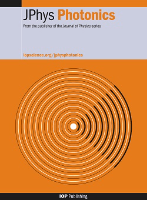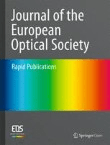
Journal of Biophotonics
Scope & Guideline
Pioneering Insights in Biophotonics Research
Introduction
Aims and Scopes
- Biomedical Imaging Techniques:
The journal covers a range of imaging techniques including optical coherence tomography, multiphoton microscopy, and photoacoustic imaging, which are crucial for non-invasive visualization of biological tissues. - Therapeutic Applications of Photonics:
Research on the therapeutic use of light, such as photobiomodulation and photodynamic therapy, is a core focus, highlighting innovative treatments for various medical conditions. - Nanotechnology in Biophotonics:
Exploration of nanomaterials, such as quantum dots and gold nanoparticles, in enhancing imaging capabilities and therapeutic efficacy through light interactions. - Spectroscopic Analysis:
The journal addresses the use of various spectroscopic techniques, including Raman and infrared spectroscopy, for the analysis of biological samples and disease diagnostics. - Machine Learning and AI in Imaging:
Integration of artificial intelligence and machine learning methodologies to improve imaging analysis, enhance diagnostics, and automate processes in biophotonics.
Trending and Emerging
- Non-Invasive Diagnostic Techniques:
An increasing number of studies are dedicated to non-invasive methods for disease detection and monitoring, reflecting a growing trend towards patient-friendly diagnostic approaches. - Hybrid Imaging Modalities:
Emerging interest in combining multiple imaging techniques, such as optical coherence tomography with fluorescence or ultrasound, highlights a trend towards more comprehensive and effective diagnostic tools. - Application of Artificial Intelligence:
The integration of AI and machine learning in image analysis and diagnostics is rapidly expanding, indicating a trend towards greater reliance on computational methods to enhance research outcomes. - Phototherapy Innovations:
Research focused on novel applications of phototherapy, including the use of light for treating a variety of conditions, is on the rise, showcasing the therapeutic potential of biophotonics. - Environmental and Health Monitoring:
Studies using biophotonics for monitoring environmental factors and their impact on health are emerging, reflecting a broader scope of applications for biophotonic technologies.
Declining or Waning
- Basic Research in Photonic Principles:
There has been a noticeable decrease in papers focusing strictly on the fundamental principles of photonics, as the journal's emphasis shifts towards applied research with direct clinical implications. - Traditional Optical Imaging Techniques:
Conventional imaging methods are being supplanted by advanced techniques, leading to fewer publications centered solely on traditional optical imaging without integration of novel technologies. - Invasive Diagnostic Procedures:
There is a waning interest in invasive diagnostic techniques, as the focus increasingly shifts towards non-invasive and less invasive methodologies for patient assessment.
Similar Journals

Photonics Letters of Poland
Empowering Researchers through Open AccessPhotonics Letters of Poland is a prominent journal dedicated to the field of photonics, published by the Photonics Society of Poland. With an ISSN of 2080-2242, the journal aims to foster knowledge and innovation within electronic, optical, and magnetic materials. Although it currently holds a Q4 classification in its category and is ranked in the 21st percentile, it serves as an essential platform for researchers and practitioners to share their findings and advancements. The journal covers a range of topics from foundational research to applied science, highlighting advancements in photonics technologies and their applications. Operating from Warsaw University of Technology, the journal promotes open access to knowledge while ensuring rigorous peer review standards. With its coverage spanning from 2009 to 2024, Photonics Letters of Poland represents a vital contribution to ongoing research within the field, making it indispensable for students, professionals, and academics looking to stay attuned to emerging trends and developments in photonics.

Biomedical Spectroscopy and Imaging
Exploring the Depths of Biomedical SpectroscopyBiomedical Spectroscopy and Imaging, published by IOS Press, is a pivotal journal in the field of biomedical engineering and imaging technologies, specifically focusing on spectroscopic methods and their biomedical applications. With an emphasis on advancing knowledge and innovation in spectroscopy and imaging, the journal serves as a vital platform for disseminating high-quality research that bridges the gap between theoretical studies and practical applications in healthcare. Despite its coverage being discontinued in Scopus after 2015, the journal continues to contribute significantly to the scientific community, fostering interdisciplinary collaboration among researchers and professionals. The journal does not have an Open Access option, which provides a unique challenge for authors and readers alike, promoting engagement with subscription-based scholarly communication. As aspiring researchers and seasoned professionals delve into its pages, they will discover a rich array of studies and insights that not only enhance their understanding but also inspire future investigations in this dynamic field.

BME Frontiers
Pioneering Insights for Tomorrow's Medical TechnologiesBME Frontiers, published by the American Association for the Advancement of Science, is an innovative open-access journal dedicated to the burgeoning field of Biomedical Engineering. Since its establishment in 2020, this journal has aimed to bridge the gap between cutting-edge research and practical application, promoting advancements in biomedical technologies, medical devices, and healthcare solutions. Boasting impressive rankings within Scopus—64th among 398 in Medicine (miscellaneous) and 81st among 303 in Biomedical Engineering—BME Frontiers stands out as a significant contributor to scholarly communication, offering rich insights for researchers, professionals, and students alike. With consistent publication projected through 2024, the journal serves as an essential platform for disseminating high-quality research that can drive innovation and inspire new approaches in the healthcare sector.

Advanced Photonics
Pioneering Discoveries in Photonics and BeyondAdvanced Photonics, published by SPIE-SOC PHOTO-OPTICAL INSTRUMENTATION ENGINEERS, is a prestigious open-access journal dedicated to cutting-edge research in the fields of photonics, optics, biomedical engineering, and material science. Since its inception in 2019, this journal has successfully established itself in the top quartile (Q1) of various categories, including Atomic and Molecular Physics, Biomedical Engineering, and Electronic, Optical and Magnetic Materials, showcasing its critical role in advancing knowledge and innovation within these disciplines. With impressive Scopus rankings—#8 in Biomedical Engineering, #7 in Atomic and Molecular Physics, and #10 in Materials Science—Advanced Photonics serves as an essential platform for researchers, professionals, and students alike, offering a wealth of accessible scholarly content to keep pace with rapid technological developments. The journal not only fosters collaboration and knowledge dissemination within the global scientific community but also emphasizes the importance of open access to ensure that groundbreaking research benefits society as a whole.

OPTICS AND SPECTROSCOPY
Advancing Knowledge in Atomic and Molecular PhysicsOptics and Spectroscopy is a pivotal peer-reviewed journal published by Pleiades Publishing Inc, focusing on the intricate fields of atomic and molecular physics, as well as optics. Established in 1972, and enjoying a legacy of convergence periods that reinforce its commitment to the evolving landscape of these scientific domains, the journal aims to disseminate high-quality research that advances our understanding of light-matter interactions, electronic materials, and spectroscopic techniques. Despite its current Q4 categorization in both the Atomic and Molecular Physics and Electronic, Optical and Magnetic Materials fields, with corresponding Scopus rankings reflecting its developing influence, the journal remains a valuable resource for researchers and professionals seeking to publish their findings, explore new methodologies, and connect with a community dedicated to innovation in optics. Although there is currently no open access option, the journal's expansive readership and its stability in publication over the decades make it an important platform for both established and emerging researchers in the field.

Journal of Physics-Photonics
Advancing Knowledge in Light and MatterJournal of Physics-Photonics, published by IOP Publishing Ltd in the United Kingdom, is an esteemed Open Access journal that has been at the forefront of research in the field of photonics since its inception in 2018. With an impressive portfolio, the journal has achieved Q1 ranking in 2023 across multiple disciplines, including Atomic and Molecular Physics, Electrical and Electronic Engineering, and Electronic, Optical, and Magnetic Materials. This positions it among the leading journals in these areas, reflecting its significant influence and contribution to advancing knowledge and innovation. The journal aims to disseminate high-quality research findings that encompass a wide range of topics in photonics, promoting interdisciplinary approach that fosters collaboration among researchers, professionals, and students. With its commitment to open access, Journal of Physics-Photonics ensures that groundbreaking research is accessible to all, empowering a global audience to engage with and benefit from the latest advancements in photonic technologies.

Biomedical Optics Express
Advancing Knowledge Through Optical TechnologiesBiomedical Optics Express, published by the prestigious Optica Publishing Group, is an open-access journal that has been at the forefront of the field of biomedical optics since its inception in 2011. With an ISSN of 2156-7085, this journal has established itself as a premier platform for disseminating high-quality research that spans an array of topics in atomic and molecular physics, optics, and biotechnology. As a testament to its scholarly impact, it is currently ranked in the Q1 category for both Atomic and Molecular Physics and Biotechnology, reflecting its commitment to excellence within these disciplines. The journal features cutting-edge articles that foster innovation and collaboration among researchers, professionals, and students who are passionate about applying optical technologies to solve pressing challenges in medicine and biology. Based in the United States, Biomedical Optics Express continues to shape the future of optical science and its applications, inviting contributions that inspire and drive forward the boundaries of knowledge.

Journal of the European Optical Society-Rapid Publications
Catalyzing Breakthroughs in Optical TechnologyJournal of the European Optical Society-Rapid Publications, with ISSN 1990-2573 and published by EDP Sciences S A, is a premier open access journal dedicated to advancing the field of optics and photonics since its inception in 2006. Based in France, this journal serves as a vibrant platform for researchers, professionals, and students to disseminate their findings quickly and efficiently. Achieving a commendable Q3 ranking in Atomic and Molecular Physics and Optics (2023), it reflects a growing impact within the scientific community, despite currently holding a 33rd percentile rank among similar publications in the realm of Physics and Astronomy. The journal fosters an environment of rapid communication and collaboration, making it an invaluable resource for those interested in the latest developments and innovations in optical sciences. With open access ensuring broad visibility for all published work, the Journal of the European Optical Society-Rapid Publications is positioned as a key contributor to enhancing the understanding and application of optical technologies.

JOURNAL OF BIOMEDICAL OPTICS
Unlocking New Frontiers in Biomedical OpticsJOURNAL OF BIOMEDICAL OPTICS, published by SPIE-SOC PHOTO-OPTICAL INSTRUMENTATION ENGINEERS, is a premier Open Access journal that has been at the forefront of research in the fields of optical engineering and biomedical applications since its inception in 1996. With an impressive range of studies that span atomic and molecular physics, biomedical engineering, and biomaterials, this journal is consistently recognized for its high-quality publications, evidenced by its Q1 quartile ranking in 2023 for Atomic and Molecular Physics and Optics. The journal’s impact is further validated by its Scopus rankings, placing it in the top 30% of its categories. Designed to facilitate rapid dissemination of innovative advancements in biomedical optics, this journal promotes an interdisciplinary approach, making it an essential resource for researchers, professionals, and students aiming to advance their knowledge and applications of optical technologies in medicine. The journal is committed to broadening access to groundbreaking research, having transitioned to Open Access in 2019, ensuring that the latest findings are available to a global audience.

Advanced Photonics Research
Advancing Knowledge, Shaping InnovationAdvanced Photonics Research is a leading open-access journal published by WILEY, dedicated to advancing the field of photonics through rigorous research and comprehensive reviews. With its ISSN 2699-9293, the journal aims to disseminate innovative findings in areas such as photonic materials, devices, systems, and applications. Since transitioning to an Open Access model in 2020, it has significantly increased accessibility for researchers, professionals, and students alike, promoting wider dissemination and collaboration within the global photonics community. The journal's commitment to high-quality, peer-reviewed content ensures it remains an essential resource for those seeking to stay at the forefront of photonics research. Positioned to influence both academia and industry, Advanced Photonics Research is an invaluable platform for sharing cutting-edge discoveries that drive the future of technology.